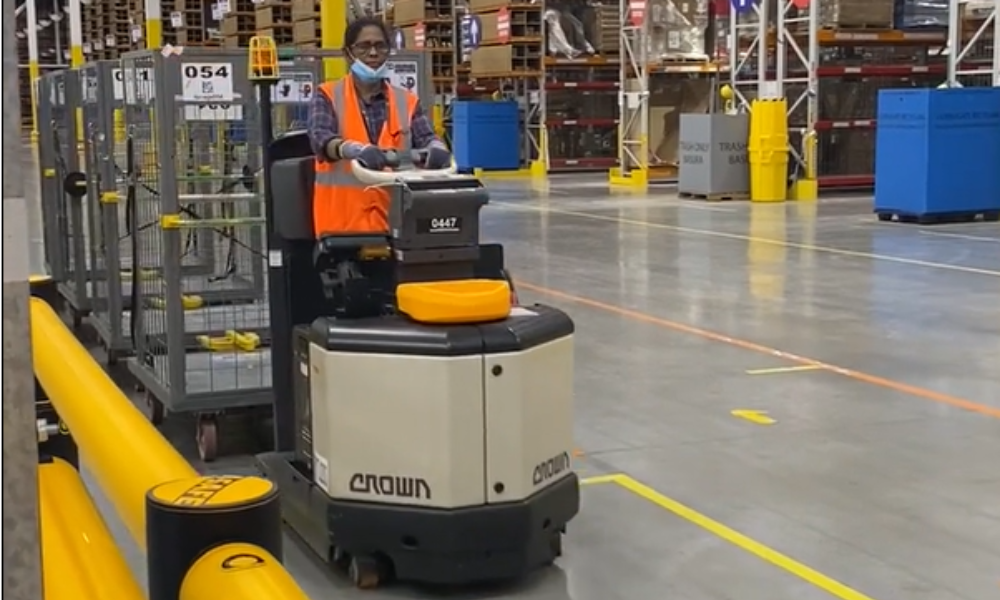Site leaders say company plans to roll out design across North America

During a recent visit to Amazon's YYZ9 Fulfillment Centre at 6351 Steeles Avenue East, Toronto, COS had the opportunity to observe one of the facility's most innovative safety features: the Powered Industrial Truck (PIT) traffic system.
"Our PIT traffic system is a pioneering initiative within Amazon, aimed at reducing the risk of accidents and enhancing overall safety," explained Komal Patel, senior operations manager at Amazon. The system incorporates clear signage, traffic lights, and designated pathways for both PITs and pedestrians.
The importance of maintaining an eight-foot distance from PITs and a twenty-foot distance from elevated machinery was emphasized during the safety briefing. "It's critical to stay mindful of these safety zones to prevent any accidents," stressed Navin Homenauth, senior safety manager at Amazon.
Innovative design and implementation
The PIT traffic system is designed to manage the movement of forklifts and other industrial vehicles within the facility. It includes designated safe zones, like the Green Mile, where no PITs are allowed, ensuring a secure walkway for employees and visitors. These measures are part of a broader strategy to minimize risks and protect everyone within the facility.
Patel provided detailed insights into the traffic system's design and functionality. "We've pioneered several best practices here that are being adopted by other Amazon facilities across the continent," she noted. This includes the strategic placement of stop signs, mirrors at intersections, and dedicated crossing points for pedestrians.
Real-time monitoring and adjustments
Another standout aspect of the PIT traffic system is its real-time monitoring capabilities. "We have cameras and sensors that continuously monitor PIT movements and pedestrian traffic," Homenauth shared. This allows for immediate adjustments to be made in response to any identified risks, ensuring that safety protocols are always upheld.
In addition to these technological measures, Amazon has implemented rigorous training programs. "Our operators undergo extensive training to ensure they are fully aware of the traffic system and adhere to all safety guidelines," Patel said. This training is complemented by regular safety drills and refresher courses to maintain high safety standards.
Feedback and continuous improvement
Amazon values the input of its associates in enhancing safety measures. "We encourage our associates to provide feedback on the PIT traffic system and suggest improvements," Homenauth emphasized. This feedback is collected through various channels, including the Dragonfly tool, which allows associates to submit safety suggestions and report any concerns.
One of the recent improvements based on associate feedback was the addition of more visual cues and markings on the facility floor. "These visual aids help reinforce safety protocols and guide both operators and pedestrians through the facility," Patel explained.
A model for the industry
The success of the PIT traffic system at YYZ9 has positioned the facility as a model for other Amazon sites and the broader industry. "Our focus on safety, efficiency, and sustainability has made YYZ9 a leading facility not just in Canada, but worldwide," Homenauth remarked. The adoption of YYZ9's best practices by other Amazon facilities underscores the site's role as a leader in workplace safety.
As the tour concluded, Patel reflected on the broader impact of the PIT traffic system. "We're proud of what we've accomplished here and remain committed to continuous improvement and innovation," she said. The implementation of such a comprehensive and effective traffic system highlights Amazon's dedication to creating a safe and efficient workplace for its associates.
Walking through the YYZ9 Fulfillment Centre, it was evident that the PIT traffic system is more than just a set of guidelines—it is a dynamic, evolving framework that other company’s using warehouses can look to for developing best practices.





